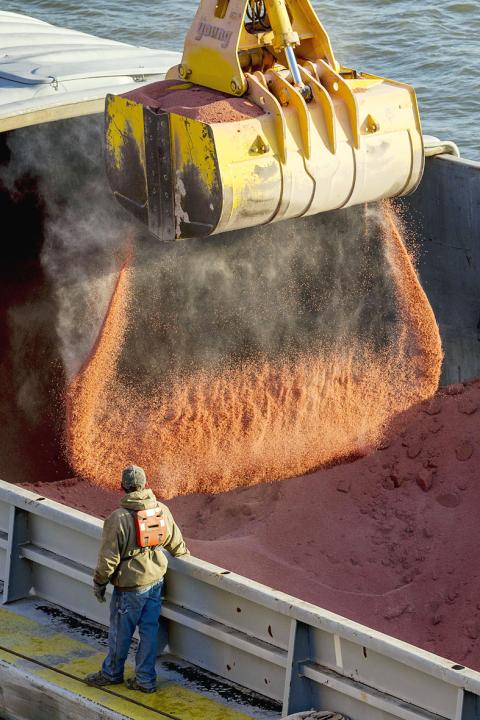Dozens of farmers in Yorkshire, England, are on the verge of becoming millionaires thanks to a 250 million-year-old layer of minerals 1.6km below their muddy boots.
Chris Fraser, a former investment banker, has submitted a planning application to mine the world’s largest deposit of potash — a powerful fertilizer — in an ancient seabed deep below the North York Moors National Park.
Fraser, who has been planning the mine for a decade, said exploratory boreholes showed that the moors held “the world’s largest and highest-quality resource of polyhalite,” a mineral-rich form of potash.

Photo: Bloomberg
If the planning application, which is supported by the local council and all neighboring members of parliament, is approved by the North York Moors National Park Authority, it will lead to the construction of the biggest British mine in a generation and create 1,000 jobs.
Landowners could be in line for a lottery-style windfall because Fraser’s company, Sirius Minerals PLC, has promised to pay out more than £1 billion (US$1.5 billion) in royalties over 50 years.
“The landowners own the minerals and we will pay them a royalty for using them,” Sirius finance director Jason Murray said.
He declined to say how much the landowners would be paid, but said a complex royalty payment formula had been agreed after two years of negotiations between 400 landowners that involved eight law firms.
“Some of them will become very wealthy,” he said. “There will be a few new tractors around the area.”
He said that some large landowners near the mine, south of the village of Sneaton, near Whitby, would become multimillionaires within a few years. If the £1 billion were split evenly between all landowners, each would get about £2.5 million.
Fraser, a former Citigroup Inc banker, will also make a packet since he owns 8 percent of the company. Other directors own about a further 8 percent, with 10 percent held by people local to the mine. The remainder is owned by institutional investors.
The potash and polyhalite deposits are the remains of a Permian-age sea that stretched from England to Poland 250 million years ago.
Geologists have known for decades that the moors contained big mineral deposits and global mining companies submitted plans for mines in the 1970s, but did not follow through when the price of potash dropped.
“Rio Tinto [Group] looked at it in the 1970s, when the prices were about US$100 a tonne,” Murray said. “Then when the price fell, lots of the data was left in a garage.”
Of the mining planning applications granted in the 1970s only one, Cleveland Potash mine near Boulby, ever began operations. It is still working today and is Britain’s biggest mine, but would be surpassed in size by the Sirius mine.
Soaring global demand for fertilizer has sent potash prices beyond £250 a tonne. Recent test drilling resulted in a near-doubling of the moor’s expected potash reserves from 1.3 billion tonnes to 2.2 billion, making it the world’s biggest potash deposit. Murray said there was so much of the mineral under the moor that there was “more than you could ever mine.”
The location of the potash inside a national park made it very difficult for global mining companies to establish projects, but Murray said that the rising price of potash has made it possible to invest more money in making the mine unobtrusive.
“As much of it as possible will be underground and what is above ground will look like farm buildings,” Murray said. “It won’t look like a traditional mine.”
The mine shafts will not be visible from the ground. Instead, miners will walk 300m down an inclined path to the top of a 1,600m lift shaft down to the polyhalite shelf.
The raw material will travel up another shaft before being crushed, mixed with salt water and pumped for 45km along a pipe to a processing plant in Teesside, Middlesborough.
“We’re using a lot of subsurface buildings,” Murray said. “It won’t see daylight until it arrives at Teesside.”
At peak production in 2020, the mine is expected to produce more than 20 million tonnes of potash a year. From the port most the potash will be exported to China, India and Brazil and other countries with large amounts of intensive farming.
Murray said the mine could also supply all of Britain’s potash demand several times over. The UK currently imports potash from Germany and Canada.
Before work on the mine can begin, Sirius needs to win approval from the park authority, which is to hold a 16-week public consultation.
The Campaign for National Parks said it was “very concerned about the negative environmental impacts of locating such a significant development in a national park.”
A spokesman said the law prevented Sirius from building the mine inside the national park if alternative sites were available, adding that Sirius had “not provided an adequate explanation” as to why it could not locate the mine outside the park.
Murray said it was “quite hard to find an isolated location that isn’t in the protected part of the moorland.”

Merida Industry Co (美利達) has seen signs of recovery in the US and European markets this year, as customers are gradually depleting their inventories, the bicycle maker told shareholders yesterday. Given robust growth in new orders at its Taiwanese factory, coupled with its subsidiaries’ improving performance, Merida said it remains confident about the bicycle market’s prospects and expects steady growth in its core business this year. CAUTION ON CHINA However, the company must handle the Chinese market with great caution, as sales of road bikes there have declined significantly, affecting its revenue and profitability, Merida said in a statement, adding that it would

Greek tourism student Katerina quit within a month of starting work at a five-star hotel in Halkidiki, one of the country’s top destinations, because she said conditions were so dire. Beyond the bad pay, the 22-year-old said that her working and living conditions were “miserable and unacceptable.” Millions holiday in Greece every year, but its vital tourism industry is finding it harder and harder to recruit Greeks to look after them. “I was asked to work in any department of the hotel where there was a need, from service to cleaning,” said Katerina, a tourism and marketing student, who would

i Gasoline and diesel prices at fuel stations are this week to rise NT$0.1 per liter, as tensions in the Middle East pushed crude oil prices higher last week, CPC Corp, Taiwan (台灣中油) and Formosa Petrochemical Corp (台塑石化) said yesterday. International crude oil prices last week rose for the third consecutive week due to an escalating conflict between Israel and Iran, as the market is concerned that the situation in the Middle East might affect crude oil supply, CPC and Formosa said in separate statements. Front-month Brent crude oil futures — the international oil benchmark — rose 3.75 percent to settle at US$77.01

RISING: Strong exports, and life insurance companies’ efforts to manage currency risks indicates the NT dollar would eventually pass the 29 level, an expert said The New Taiwan dollar yesterday rallied to its strongest in three years amid inflows to the nation’s stock market and broad-based weakness in the US dollar. Exporter sales of the US currency and a repatriation of funds from local asset managers also played a role, said two traders, who asked not to be identified as they were not authorized to speak publicly. State-owned banks were seen buying the greenback yesterday, but only at a moderate scale, the traders said. The local currency gained 0.77 percent, outperforming almost all of its Asian peers, to close at NT$29.165 per US dollar in Taipei trading yesterday. The